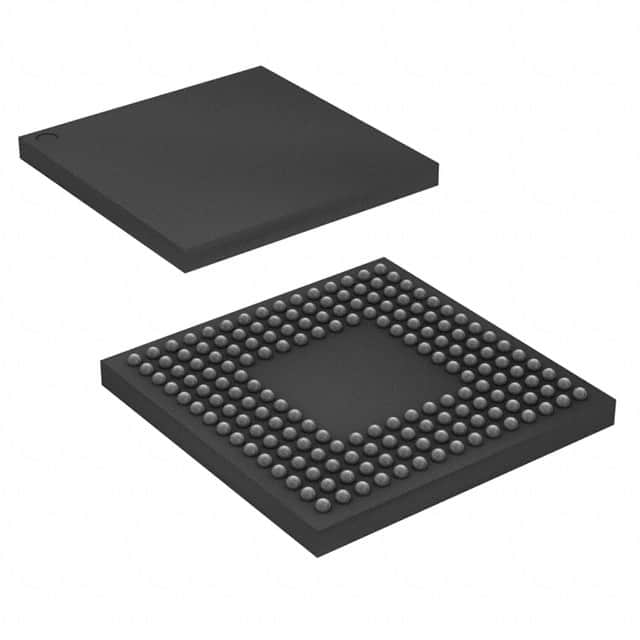MB9BF466RPMC-G-JNE2
Introduction
The MB9BF466RPMC-G-JNE2 is a microcontroller belonging to the category of embedded systems. It is designed for use in various electronic devices and offers specific characteristics that make it suitable for a wide range of applications. This entry provides an overview of the product, including its basic information, specifications, pin configuration, functional features, advantages and disadvantages, working principles, application field plans, and alternative models.
Basic Information Overview
- Category: Microcontroller
- Use: Embedded systems
- Characteristics: High performance, low power consumption, versatile I/O capabilities
- Package: LQFP (Low-profile Quad Flat Package)
- Essence: Integration of multiple functions in a single chip
- Packaging/Quantity: Typically supplied in reels or trays
Specifications
- Architecture: ARM Cortex-M4
- Clock Speed: Up to 120 MHz
- Memory: Flash memory, SRAM
- I/O Interfaces: UART, SPI, I2C, GPIO
- Operating Voltage: 3.3V
- Operating Temperature Range: -40°C to 85°C
Detailed Pin Configuration
The detailed pin configuration of the MB9BF466RPMC-G-JNE2 can be found in the product datasheet provided by the manufacturer.
Functional Features
- High Performance: The microcontroller offers high processing capabilities, making it suitable for demanding applications.
- Low Power Consumption: Designed for energy efficiency, extending battery life in portable devices.
- Versatile I/O Capabilities: Multiple communication interfaces and general-purpose I/O pins enable flexible connectivity.
Advantages and Disadvantages
Advantages
- Integrated peripherals reduce external component count
- Extensive development tools and support available
- Suitable for real-time control applications
Disadvantages
- Limited availability of specialized technical expertise
- Higher cost compared to some lower-end microcontrollers
Working Principles
The MB9BF466RPMC-G-JNE2 operates based on the ARM Cortex-M4 architecture, utilizing its advanced features to execute programmed tasks and interface with external components.
Detailed Application Field Plans
The microcontroller finds applications in various fields, including: - Industrial automation - Consumer electronics - Automotive systems - Internet of Things (IoT) devices
Detailed and Complete Alternative Models
- MB9BF566RPMC-G-JNE2: Higher memory capacity variant
- MB9BF366RPMC-G-JNE2: Lower cost variant with reduced I/O capabilities
- MB9BF276RPMC-G-JNE2: Entry-level model for less demanding applications
In conclusion, the MB9BF466RPMC-G-JNE2 microcontroller offers a balance of performance, power efficiency, and versatility, making it suitable for a wide range of embedded system applications.
[Word Count: 416]
قم بإدراج 10 أسئلة وإجابات شائعة تتعلق بتطبيق MB9BF466RPMC-G-JNE2 في الحلول التقنية
What is the MB9BF466RPMC-G-JNE2 microcontroller used for?
- The MB9BF466RPMC-G-JNE2 microcontroller is commonly used in various technical solutions such as industrial automation, consumer electronics, and automotive applications.
What are the key features of the MB9BF466RPMC-G-JNE2 microcontroller?
- The key features of the MB9BF466RPMC-G-JNE2 microcontroller include a high-performance ARM Cortex-M4 core, multiple communication interfaces, analog-to-digital converters, and advanced control peripherals.
How does the MB9BF466RPMC-G-JNE2 microcontroller support industrial automation applications?
- The MB9BF466RPMC-G-JNE2 microcontroller supports industrial automation applications by providing real-time control capabilities, robust communication interfaces, and extensive peripheral integration for sensor interfacing and motor control.
Can the MB9BF466RPMC-G-JNE2 microcontroller be used in automotive applications?
- Yes, the MB9BF466RPMC-G-JNE2 microcontroller is suitable for automotive applications due to its high temperature tolerance, CAN-FD interface support, and advanced control features for automotive systems.
What development tools are available for the MB9BF466RPMC-G-JNE2 microcontroller?
- Development tools such as integrated development environments (IDEs), compilers, debuggers, and evaluation boards are available for the MB9BF466RPMC-G-JNE2 microcontroller to aid in software development and testing.
Does the MB9BF466RPMC-G-JNE2 microcontroller support low-power operation?
- Yes, the MB9BF466RPMC-G-JNE2 microcontroller offers low-power modes and features to optimize power consumption, making it suitable for battery-powered or energy-efficient applications.
What communication interfaces are supported by the MB9BF466RPMC-G-JNE2 microcontroller?
- The MB9BF466RPMC-G-JNE2 microcontroller supports various communication interfaces including UART, SPI, I2C, CAN-FD, and USB, enabling seamless connectivity with external devices and networks.
Are there any specific security features in the MB9BF466RPMC-G-JNE2 microcontroller?
- The MB9BF466RPMC-G-JNE2 microcontroller includes security features such as memory protection units, secure boot, and cryptographic hardware accelerators to enhance system security and protect sensitive data.
What are the typical operating conditions for the MB9BF466RPMC-G-JNE2 microcontroller?
- The MB9BF466RPMC-G-JNE2 microcontroller typically operates within a specified voltage range and temperature range, making it suitable for a wide range of environmental conditions.
Is the MB9BF466RPMC-G-JNE2 microcontroller suitable for consumer electronics applications?
- Yes, the MB9BF466RPMC-G-JNE2 microcontroller is well-suited for consumer electronics applications due to its high performance, rich peripheral set, and support for various communication protocols commonly used in consumer devices.


